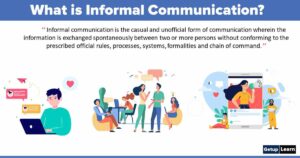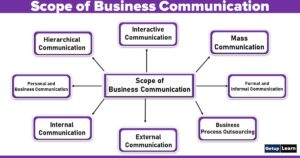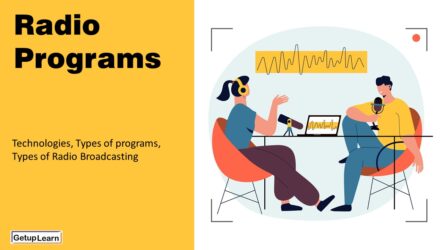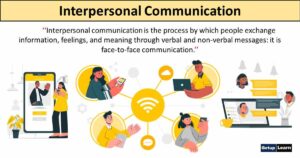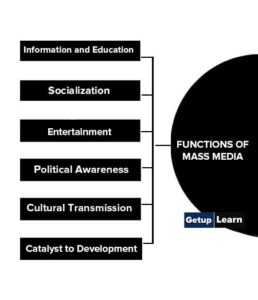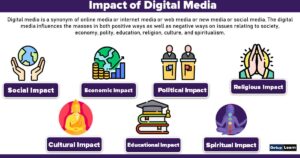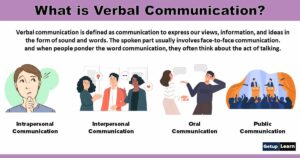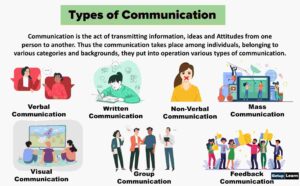Table of Contents
What is Communication?
Dreaming, talking with someone, arguing in a discussion, speaking in public, reading a newspaper, watching a TV program, etc. are all different kinds of communication that we are engaged in every day. It means that we are constantly exchanging our thoughts, ideas, and motions with someone or other either to satisfy our physical, emotional, or other needs or to get work done.
Table of Contents
It is obvious that communication is an integral part of one’s life. In fact, society cannot survive in the absence of communication.
Communication is more than mere transferring or transmission of ideas or thoughts. It is not a static act as some of the earlier definitions suggest but it is a dynamic process of action and interaction towards the desired goal as suggested by later definitions.
Definition of Communication
Communication is a process of sharing or exchange of ideas, information, knowledge, attitude, or feeling among two or more persons through certain signs and symbols.
Communication, in simple words, is the transmission of a message or idea from the sender to the receiver. The sender may be a person or a group of persons, who transfer thoughts or ideas to a destination. The destination may also be an individual or group that receives the messages.
Elements of Communication
The shift in communication technology over time changed the very process of communication in various ways, adding new elements or skipping the existing ones. A clear understanding of the elements of the communication process is essential to know what happens in the communication process in various contexts.
Communication is the expressions that we send and receive from our environment. It is a dynamic process that involves a series of activities such as observations, actions, reactions, postures, gestures, and so on.
There are certain elements inevitable in a communication process. They are:
Sender
The sender or source may be an individual (speaking, writing, drawing, gesturing), or a communication organization ( a newspaper, publishing house, television station, or a motion picture studio). The sender may use oral, written, graphic signs or symbols to convey the message.
The communication skills, attitudes, and convictions, the knowledge of the content, objectives, socio-cultural milieu, etc. of the sender have an impact on the effectiveness of communication.
A sender decides and encodes his ideas into a message. Encoding is the process of transferring ideas into the form of signals or messages and then transmits them through a channel.
For example, a writer first decides the topic for his article, he then encodes it into a language (the text) and finally transmits it by writing the content.
Message
The message is anything that is sent or received through the sensory channels in a communication process. They can be verbal and nonverbal. Verbal messages are the written or spoken words in a language. Nonverbal messages can be the dress code, gestures, posters, tone and pitch variations of sound, color, and space.
Channel
Channel is the medium that carries the message from a sender to receiver. In a face-to-face situation, the air is the channel. 19 The air carries sound waves from the sender’s mouth to the ears of the receivers. In mass communication, the mass media like newspapers, radio, and television work as channels.
In the case of the telephone, the telecommunication system is the channel.
Receiver
The receiver is the actual recipient of messages in a communication process. After receiving the message he decodes the message. Decoding is the process of interpreting the message sent by the source. Through decoding the meaning of the message is created in the mind of the receiver.
Feedback
Feedback is the response to the sender’s message by the receiver. After interpreting the meaning of a message, the receiver encodes his response into another message. Then it is sent to the sender through a medium.
For example, in a classroom, students raise doubts or nod their heads in agreement with what the teacher had already communicated to them. The act of accessing one’s own message is self-feedback. That is, a speaker hears his own words as he speaks.
Noise
Noise in communication refers to anything that distorts or interferes with the message. Noise occurs in all forms of communication. They are also called barriers to communication.
Given below are different types of noise:
-
Channel Noise: Any disturbance that occurs to the medium. When a weak signal may result in poor reception, it is called channel noise.
-
Psychological Noise: Anything that interferes with the psyche of the participants of a communication process. At the time of a personal interview for a job, candidate’s fear becomes a psychological noise. The fear can affect the flow of his talk and overall performance badly.
-
Semantic Noise: Any problem related to language. Unfamiliar words, complex sentences, poor grammar etc. create semantic noise.
- Contextual Noise: Sometimes a situation itself is a barrier to communication. For example one cannot talk casually in an official meeting.
Context
Context is the situation where a communication activity takes place. Communication always occurs within a context. The context defines the nature of every communication. It can restrict or complement your mode of communication.
For example, your behavior in a classroom will be different from that of a playground.
Effect
The consequences of the communication process are termed as effects. Every act of communication makes some effects on its participants. The effect may be positive or negative. A successful communication process achieves the desired effect.
Public speakers are said to be successful only when their ideas are understood and accepted by the audience.
Types of Communication
Communication takes place at different levels and accordingly we can speak of different types of communication:
Intrapersonal Communication
When communication takes place within oneself, it is called intrapersonal communication. It includes individual reflection, meditation, and contemplation. Intrapersonal communication includes prayers addressed to the divine though some authors describe communication with the divine as Transpersonal Communication.
Interpersonal Communication
Interpersonal communication takes place between two persons. This includes dialogue, conversation, or exchange of views between two persons without using any technological devices like the telephone. It is direct, intimate, and consists of verbal interaction or gestures.
The efficacy of interpersonal communication depends very much on the mutual relationship between the two partners in communication, their status, roles, and skills.
Group Communication
Group communication takes place among a group of persons. It shares most of the qualities of the above types of communication, though in a much-reduced way. The number of receivers increases, but participation, intimacy, etc. can become lesser and lesser as the group becomes larger and larger.
Mass Communication
When the audience is large, heterogeneous, and widely dispersed, the communication is called Mass Communication. Scientific and technological advances have made it possible to make communication reach a vast audience within a short time.
Functions of Communication
Following are the functions of communication which we will discuss below:
Information
The information function serves to provide knowledge to the individual’s need for guidance in their actions. Information also fulfills worker’s desires for awareness of things that affect them.
Instructive
The command and instructive functions serve to make the employee aware of his obligations to the formal organization and to provide him with additional guidance on how to perform his duties adequately.
Influence and Persuasion
The influence and persuasion function (also known as a motivational function) encourages the appropriate individual to perform or to exhibit a certain behavior. Messages communicated are used to convince individuals that their actions can be personally or organizationally beneficial.
Integrative
The integrative function refers to the fact that the communication of messages/ideas if properly handled, should help to relate the activities of the workers to their efforts complement rather than detract from each other.
Work efforts are unified rather than fragmented as a result of properly integrative communication. Employees can perform well and be involved in their work only when they understand their job duties and responsibilities.
Unless the organization’s key goals, values, and strategies are communicated to employees, they will not work in that direction.
FAQs About Introduction to Communication
What are the elements of communication?
The following are the elements of communication:
1. Sender
2. Message
3. Channel
4. Receiver
5. Feedback
6. Noise
7. Context
8. Effect.
What are the types of communication?
These are the major 4 types of communication:
1. Intrapersonal Communication
2. Interpersonal Communication
3. Group Communication
4. Mass Communication.
What are the functions of communication?
The following are the functions of communication:
1. Information
2. Instructive
3. Influence and Persuasion
4. Integrative.



